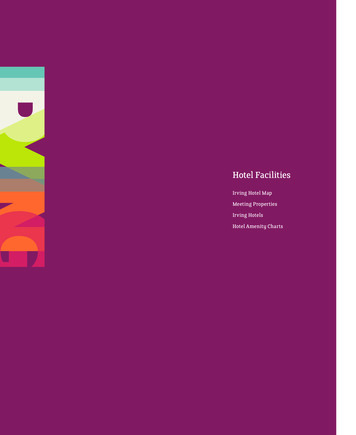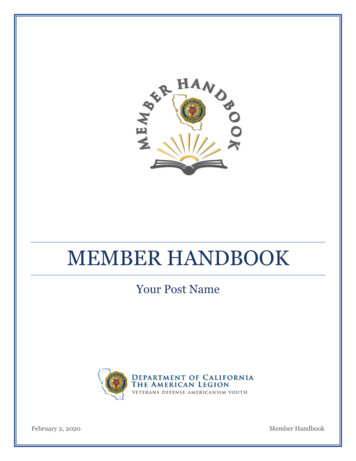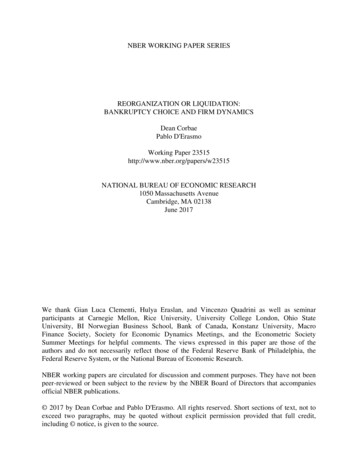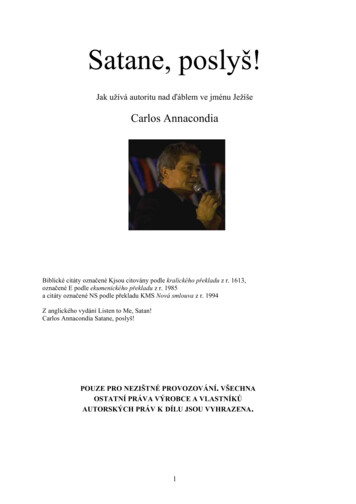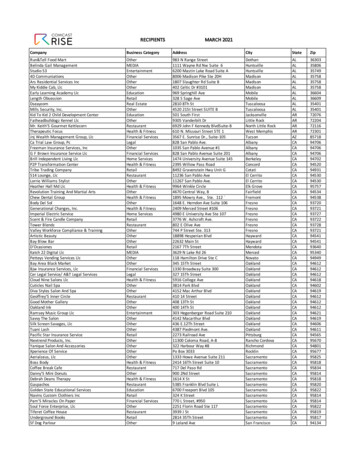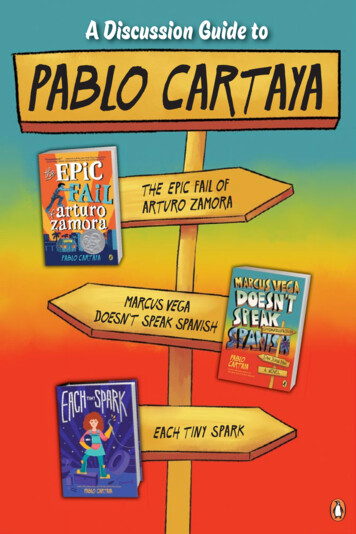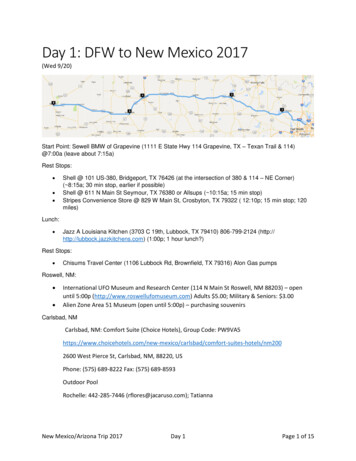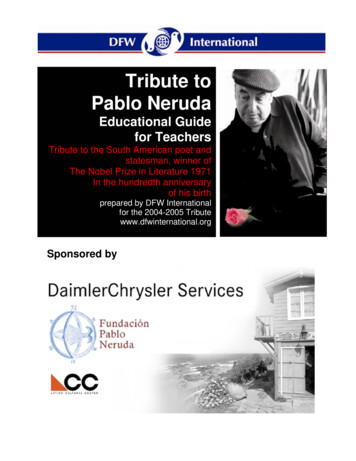
Transcription
Tribute toPablo NerudaEducational Guidefor TeachersTribute to the South American poet andstatesman, winner ofThe Nobel Prize in Literature 1971In the hundredth anniversaryof his birthprepared by DFW Internationalfor the 2004-2005 Tributewww.dfwinternational.orgSponsored by
presentsERUDA: July 12, 2004 to July 11, 2005Tribute to the South American poet and statesman,winner of the Nobel Prize in Literature, 1971on the hundredth anniversary of his birthPART IIIChileArts andCraftsResources50 institutions and cultural groups across North Texasparticipating in 40 cultural and educational eventsPoetry that brings alive a continent's destiny and dreams."“Poetry in harmony with Man and the Earth.”“Poetry with the overflowing vitality of an awakening continent”Born in Chile on July 12, 1904, Pablo Neruda created romanticand epic poetry as well as drama and prose that captured theessence of America. Neruda was Latin America’s mostprominent 20th century poetic voice. His simple words inspiredgenerations of lovers and gave voice to the common strugglesof peasants, miners, factory workers. His love for the Americasburst forth in images of the sea and the flora and fauna.Neruda was much more than a Nobel Prize winning poet. Hewas a diplomat, an ambassador to France, a communistsenator, a candidate for the presidency of Chile, a politicalfugitive, the winner of the World Peace Prize. His friendsranged from carpenters and fishermen to Pablo Picasso andDiego Rivera, Gandhi, Che Guevara and Salvador Allende.Neruda was known as the "poet of the people", the voice forthe voiceless who fought passionately for social justice.“Poetry is an act of peace,” he wrote. “Peace goes into themaking of a poet as flour goes into the making of bread.”We are grateful for the support of"I have always wanted the handsof the people to be seen in poetry.I have always preferred a poetrywhere the fingerprints show.A poetry of loam,where water can sing.A poetry of bread,where everyone may eat."Contact us at:neruda@dfwinternational.org214-340-9707Neruda was the most prominent 20th century poetic voice ofLatin America, a man whose voice resonates to all our international populations. Lover, politicalactivist, the voice of the common man--Pablo Neruda speaks to today's concerns and all people.80
This Teacher’s Guide was prepared by Anne Marie Weiss-Armush, President of DFW International, for theTribute to Pablo Neruda centennial festival. It is offered FREE of charge and may be downloaded from ourwebsite at www.dfwinternational.org. Questions may be addressed to neruda@dfwinternational.org .We are especially grateful to Teresa Nguyen, student at the Southern Methodist University in Dallas, whodesigned the Arts and Crafts activities.Every effort has been made to credit sources and to obtain permission for use of materials cited. Whentranslator’s name is not noted, that particular poem was found on the internet, and the translator was notgivenINDEXPart III. ChileGeography, culture, resources from Searingtown School .83Geography from Sernatur National Tourism Agency of Chile .86Part IV. Hands-on educational projectsA. FlagB. FruitC. KitesD. Lapiz LazuliE. Seashell frameF. FishG. Mapuche ponchoH. Mapuche silver jewelryI. Easter Island headbandJ. Original art project reflecting Mapuche influencesK. 3 dimensional map of ChilePart V. Resource materials and website linksNorth Texas Artists 103Internet Resources 103Neruda: Biography and general informationNeruda: Pages of linksPoems in English and SpanishPoems in SpanishPoems in EnglishNeruda and Chile in filmFilms about Neruda by Manuel BasoaltoFilms about Neruda by Hugo ArévaloFilms about ChileEaster Island: Chile’s government and politicsFilm Resources .104Lesson plans and teaching materials . .10581
Page produced by Searingtown School106 Beverly Dr, Albertson, NY 11507"Karen Kliegman" gtown/cultures/chile.htmGeographyChile is located in the continent South America.Chile stretches over 4,300 km along the southwestern coast of South America. The samedistance from San Francisco to New York.PopulationChile's population of almost 15.2 million isgrowing annually at 1.17 percent, one of thelowest growth rates among South Americacountries. Only about fifty percent of thepopulation lives in rural areas. More than fivemillion people live in Santiago metropolitanregion. About 95 percent of the people haveeither a European heritage or are of mixedEuropean- indigenous descent.ClimateChile's Climate is varied by its land formation(Ex: mountains). It rains the most between Mayand August when temperatures are cooler,getting down to an average of 10 degrees C.January's average temperature is 28 degrees C.The summer is only 11 degrees C.82
EconomyFoodChile must bring in much of its food,petroleum, and manufacturing goods. Topay for this they depend on the export ofcopper and other minerals. In most yearsChile has a serious balance of paymentsdeficit because its exports income is farless than the cost of its imports.Beans, potatoes, and bread are some staples in Chile.Pebre is a popular hot sauce. The preferred meats inChile are beef and chicken. In Chile they eat a lot ofseafood, too.GovernmentA lot of famous poets are from Chile. Gabriel Mistral isoften referred to by Chileans as divine. She became thefirst Latin American to win the Nobel Peace Prize.Cultural ArtsIn Chile the government type is republic.Local government is divided into 13regions for purposes of local government.The regions are than further divided into54 provinces. In National Government the The most important holiday to the Chileans ispresident serves as head of state. TheIndependence Day. It's a celebration of the country'spresident is elected to a four year- term.freedom from Spain. The holidays last for 2 days. Thearmed forces stage a large parade in Santiago attendedby the president. Smaller parades are attended aroundthe Country. It's followed by a rodeo.Holidays and FestivalsReligious BeliefsSpanish colonists brought the RomanCatholic religion to Chile. Today about 80percent of all Chileans are Catholics. TheCatholic church operates many schools inChile, and Church leaders have activelypromoted political and social reforms.Social EtiquetteEducationOn the whole Chileans are a warm andaffectionate people. Greetings are typicallya cheerful occasion involving plenty ofThe educational systems have been changing. In thephysical touching.past 30 years many problems have been solved and newhave arisen. The country now has 95% literacy rate,100% children have access to elementary school system,and 70% to the education at high school level. Theschool system is organized in on a decentralized basis,giving the towns and the sector- families, teaches,foundations, and corporations- the responsibilityChileans use a lot of expressive handmanage the schools. A subsidy system finance bothgestures when they are talking.town schools and a high percentage of private schools.But criticism remains, focusing on a low quality, rigidity,inequity and inefficiency of the system.Non-VerbalCommunicationLanguageSpanish called Castellano, is the officiallanguage. But as in all South Americancountries, some terms common to Chilewill not have the same meaning elsewhere.Chilean's commonly add a suffix to wordsand names to form diminutives. For83
example, Chaoito is a "small good bye,"while Carlitos means " little Carlos."English is taught in the schools and isunderstood by many with formaleducation. Small minority groups alsospeak German( in southern Chile) andMapuche.EnglishHellogood byethank youOneMilkFun and RecreationChilean's love flying kites. Catholic monks brought thefirst kites to Chile in the 18th Century. Today, people atall ages fly kites for sport and amusement in the springand summer. Kites have even honored in Chileanliterature as a national treasure.Translationholáadíosgraciásunoleché84
Material on Chile’s regions from Sernaturthe National Tourism Agency of Chilehttp://www.sernatur.cl/inicio.htmmap from Lonely Planethttp://www.lonelyplanet.com/85
86
Part IV Chilean Ats and Crafts ProjectsA. CHILEAN FLAGThe flag of Chile occasionally getconfused with that of Texas. On the Texanflag the white star is on a blue verticalstripe which runs across both the whiteand red stripes, rather than on the bluecanton of the Chilean flag.The NationalFlag of Chile used today is said to havebeen conceived by Minister of War,Colonel Jose Ignacio Zenteno anddesigned by Antonio Arcos, a Spanishmilitary officer. The flag was officiallylegalized by legal decree on October 18,1817.Fun facts:Red stands for bravery and the blood of the heroes.White is for the snow of the Andes Mountains.Blue is for the Chilean sky and the White star stands for the honor and progress of the country.Crafts:La Bandera1. Pinwheel with Chilean flag colorsSupplies needed: 2 pieces of construction paper (the thicker the better)ScissorsA hole punchA push-pinA pencil with an eraserMarkers or crayonsPero levántatetú, levántate,pero conmigo levántatey salgamos reunidosa luchar cuerpo a cuerpocontra las telarañas del malvado,contra el sistema que reparte elhambre,contra la organización de la miseria.The FlagBut stand up,you, stand up,but stand up with meand let us go off togetherto fight face to faceagainst the devil’s webs,against the system that distributeshunger,against organized misery.1. Start by making two square pieces of paper.2. To start making a square, put the two pieces of papertogether. Fold the corner of the pieces of paper overas shown.2. To finish making the squares, cut off the smallrectangles, forming two squares (which are alreadyfolded into a triangle).3. Fold the triangle in half. Unfold the paper.4. Decorate one side of each sheet of paper.5. Put the undecorated sides of the paper together.6. Make four cuts along the fold lines - about halfway to the center.7. Punch four holes in the pinwheel, one at each corner.1. Gently gather each of the four points (with a hole) to the center. (Be careful not to creasethe paper.)87
2.Push a push-pin through the four punched holes through the center of the pinwheel toattach the pinwheel to the side of a pencil's eraser.B. FRUITSThe most developed agricultural industry is Chile’s fruits—GRAPES, apples, apricots, pears,walnuts, almonds, plums, cherries, olives, oranges, lemons, avocados and cherimoya.Being a thin strip of land stretching from 17degrees in the north to 56 in the south has giventhe country a wide range of climates and made itsuitable for a huge array of fruit crops. Chile is acountry unlike any other on earth. Stretchingnorth to south for 2,600 miles the nation extendsthrough several climactic zones, from the hot ariddesert conditions in the north to the cold Antarcticinfluences in the south. The country is safelysheltered by its borders, which form naturalbarriers to insects and disease. These conditionscreate a sanctuary of sorts for the flourishing ofits wide variety of fruits. When blight hits the fruitsand vegetables in Europe and the United States,frequently the Chilean fruits remain unaffected.Chile’s fruit sector provides summer fresh fruits tocountries like the United States in the northernhemisphere even during the middle of winter. Italso provides winter fruits, on those hot summerdays in the north.Fun Facts: Chile is one of the world’s primary producers of grapes and wine. Most of the grapes we inthe US consume in winter, come from Chile. The amount of land dedicated to vineyardsand grapevines in Chile is actually greater than the entire are occupied by all fruit trees puttogether, covering eight regions and over 1000 kilometers! That’s 11,000 football fields!Crafts:1. Fruit mobileEra la sed y el hambre,y tú fuiste la fruta.Era el duelo y las ruinas,y tú fuiste el milagro.Supplies needed: Construction paperScissorsCrayons, paint or markersYarn or stringGlue (or a stapler)To make a mobile: twigs or clothes hangerwireThere was thirst and hunger,and you were the fruit.There were grief and ruins,and you were the miracle.1. Fold a piece of construction paper in half and draw the outline half of a fruit on it around thefold line. Cut along the line. Using the finished fruit as a template cut two more exactly likeit.88
2. For cored fruit (like the apple), cut out a semicircle from each piece (when you open thefruit, there will be a circle missing from its center).3. Color both the fronts and the backs of the fruits you just cut out to look like a cross-sectionof the fruit (showing both the inside and the peel of the fruit).4. For hollowed-out fruit (like the cored apple), on one piece, cut halfway through the fold linefrom the core. On the other two pieces, cut halfway through the fold line from the outside.5. For solid fruit (like the watermelon), on one piece, cut halfway through the fold line from thebottom. On the other two pieces, cut halfway through the fold line from the top.6. For hollowed-out fruit (like the cored apple), cut out a few tiny seeds from dark constructionpaper. Glue or staple a string to the fruit along a fold line - make sure that the string extendsthrough most of the core. Glue the seeds to the part of the string within the core (gluing twoseeds to each other around the string works well).7. For the solid fruit (like the watermelon), glue or staple the end of a length of string or yarn tothe top of the fruit.8. For grapes, cut out the form of a bunch of grapes, and draw in individual grapes in thecluster.9. Cut a leaf or two from green construction paper. Glue to the top of the fruit or to the string.You can now hang your beautiful 3-D fruit from the string.10. To make a fruit mobile, tie twigs or clothes hanger wire together to make the mobilestructure. Then hang your fruit from the structure. Hang the entire mobile from anotherstring.C. KITESEl viento es un caballo:óyelo cómo correpor el mar, por el cielo.Chileans love to fly kites. The winds born by the seas hit theAndes mountains in powerful gusts. Catholic monks brought thefirst kites to Chile in the 18th Century. Today, people at all ages flykites for sport and amusement in the spring and summer.Quiere llevarme: escuchacómo recorre el mundopara llevarme lejos.Fun facts: Kites have even honored in Chilean literature as a nationaltreasure.The wind is a horse:hear how he runsthrough the sea, through thesky.He wants to take me: listenhow he roves the worldto take me far away.Pablo NerudaCrafts:1. KitesSupplies needed: 3 plastic straws transparent tape tissue paper crepe paper streamers string scissors1. You'll create an H-shaped frame that you'll glue or tape some paper onto. First you'll make some notches on the two ends of one straw. This piece will be thecenter bar of the H-shaped frame. Carefully make one-inch cuts down the center of theends of the straw. Now cut halfway across the straw at the bottom of each vertical cut. Halfof the straw falls away and the other half remains. The result is a straw with notched ends.89
Wrap the notched ends around the midpoints of the two vertical plastic straws. Secure thisconnection with tape.Run the string through all four open ends of the straws. This will create a square. Tie anoverhand knot and then a second one on top of the first one. Cut the string so that it's taut,yet doesn't bend the straws.Cut one-inch squares out of the corners of a 10" by 12" piece of tissue paper. Place it underthe frame that you've made.Fold the ends of the paper back over the straws and string. Secure the paper with tape orglue. The paper should be taut without bending the straws.Cut the crepe paper to make two tails, each one 3' long. Tie them to two corners of the kite,where the two vertical straw ends stick out.2. Make the string bridle Cut two small holes in the paper, just below the point where the ends of the center strawconnect the two vertical straws.Cut a piece of string about ten inches long. Thread it through the hole closest to the tails.Loop it around the center straw, and back through the same hole in the paper. Tie a doubleoverhand knot to secure the string to the straw.Taking the end of the main control line, feed it through the other hole and tie it to the strawon that side.Finally, tightly tie the loose end of the first piece of string to the main control line, aboutthree inches down from the paper.There lives the blue mother-of-blue;blue's secret, blue solitude;blue's aerie, lapis lazuli blue;the blue spine of my country.Pablo NerudaD. LAPIZ LAZULIChile’s tradition with lapis lazuli dates back to thetime of the Chimu tribes that lived in the northern part of the country. In the Ovalle area of Chile, atan altitude of 12,000 feet, rests the unique mineral vein of lapis lazuli. Because of the extremeconditions this site can only be mined during the summer months. Chile named the Lapis Lazuli asits National Stone on September 20, 1984.Because it is beautiful, rare, its rich blue color and brilliant finish, it has become one of thepreferred and most sought after stones that artisans work with. From the gemstones, artisansmake different carved objects as well as elegant jewelry and silverwork of very original designs.Fun Facts: The Pharaohs already knew this blue stone before our Era. Queen Cleopatra used it asa personal adornment.Legend also reveals that this stone holds magical healing elements that were wellknown by the ancient people. For example, because of its high sulfur content lapis lazulipowder was used to fight skin disease and for treating epilepsy and anemia. It is saidthat lapis lazuli is an omen for good luck, love, power and wealth.Crafts:90
Ode to the seaby Pablo Neruda1. Lapiz Lazuli potterySupplies needed: Play-doh or clay Plastic utensils Plastic blue gemstones paintsMy name is sea.1. take a little piece at a time from the clay2. begin molding a vase, plate or mug (do not eat off ofthese)3. use the spoon to carve at certain areas or the fork to makedesigns4. carve out areas to insert the gems and make sure the claysecures the gem5. leave it overnight without a cover to dry6. once it is dry, paint on top of your designs to give it color7. Enjoy!E. FISHChile is currently third in the world for total catch of fish. It exportsprincipally to the United States and to Japan.The Silver Salmon has the color silver running down its sides andhas small black spots sprinkled along its back. These spots arealways roundish or oval. Spots on the Silver Salmon are smallerthan the Atlantic Salmon and it does not have any spots on its tail.Fun Facts:It slaps the rocksAnd when they aren't convinced,Strokes themAnd soaks themAnd smothers them with kisses.With seven green tonguesOf seven green dogsOr seven green tigersOr seven green seas,Beating its chest,Stammering its name,Oh Sea,This is your name.Oh comrade ocean,Don't waste timeOr waterGetting so upsetHelp us instead.We are meager fishermen,Men from the shoreWho are hungry and coldAnd you're our foe.Don't beat so hard,Don't shout so loud,Open your green coffers,Place gifts of silver in our hands.Give us this dayour daily fish.Pablo Neruda Most of the salmon and trout we purchase in the UnitedStates is from Chile. The Silver and Atlantic Salmon can grow up to 3 feet inlength---the length of a baseball bat! During the last decade food production for the salmon industry jumped from 50,000 tons in1990 to 700,000 tons in 2003.Crafts:1. Fish windsockSupplies needed: Assorted color construction paper 8”11” Transparent tape or a stapler glue Assorted color of crepe paper or rolls of streamers Scissors Googly eyes (optional) Glitter (optional) Silver sparkles or confetti (optional)91
MarkersHole puncherYarn or string1.2.3.4.5.6.7.8.Fold an 8”11” construction paper in half (lengthwise)draw 2 fish patterns on the two folded sidesdecorate the 2 fishes with silver glitter and black dots to emphasize the Silver Salmonglue the eyes on or draw them oncut out the patternsglue it on another 8”11” construction paper (lengthwise)cut 5 streamers or crepe paper to lengths of 2 feetstaple or glue it to the opposite side from the fishes so it hangs from the construction paper(1 inch apart from each other(9. take the ends of the construction paper and roll it into a cylinder10. secure with tape or staples11. punch 2 holes at the top and tie a yarn or string on it12. Now, you can hang your fish outside so it can catch the wind!F. Fish paper plateComo ausencia extendida, como campanasúbita,el mar reparte el sonido del corazón.Supplies needed: Like an extended absence, like a subtle bell,the sea distributes the sound of the heartPablo NerudaPaper plateScissorsGlue (or tape or a stapler)Googly eyes (optional)Crayons, paint or markers1. Cut a wedge out of a paper plate. The wedge will be the fish's tail; the hole will be the fish'smouth.2. Glue (or use tape or a stapler) the tail to the end of the fish. Glue a googly eye on the fish(glue on two eyes if you want a flounder) or simply draw eye(s).3. Color in the fish, drawing scales, lips, and so on.For added touches, you can tape the fish to a blue butcher paper backdrop or hang it up with anattached string.G. Seashell Frame Chile's great poet-hero was amerman who so loved the sea that he built hishouse and filled it with shells, figureheads, modelsailing ships and mermaids. He had a roomespecially for his collection of 6,000 seashells.He placed his bed diagonally in his bedroom inorder to wake up facing the inspiring Pacific. Histelescope stayed handy on the bedside table.Fun Fact:92Y suena el corazón como un caracol agrio,llama, oh mar, oh lamento, oh derretido espantoThe sea sounds like a bitter snail shell,it calls, oh sea, oh lament, oh melted frightPablo Neruda
Once he spied a wooden hatch washed off a ship and told his wife his new desk was on itsway. Sure enough, he fished it from the surf and made it into a writing table.Supplies needed: Jumbo popsicle sticksGlueColor sandSeashells1. make the frame by gluing four popsicle sticks2. glue the seashells on top3. put glue on the sticks and sprinkle the sand ontop4. Once, you have a wonderful dried frame, find apicture you like and frame it!H. Mapuche Indian projectsThe Mapuche are the "people of the land", Mapu meansland and che means people. They are also known asAraucanos, a name given to them by the Spanishcolonialists. Before the "huincas" (‘thieves of the land’ orSpanish) arrived in 1541, the Mapuche who numberedone and half to two million were the original inhabitantsof the Southern Cone of the continent in a region whichtoday covers half of Chile and half of Argentina.The Mapuche are the only indigenous group whichwithstood the attacks of the Inca and were neverconquered by them. They are also the only SouthAmerican indigenous group which was never conqueredby the Spanish invadors, even after 100 years of brutalwar.MAPUCHE-PonchosMapuche textiles are usually ingeometric shapes and in bold colors.Their patterns are usually formed by nested,stepped diamonds or chevrons. Theusually make these patterns with twodifferent colors. They use vegetable androcks like dusts of several colors to dyewool. They are made in a technique called"warp ikat," in which the threads are tieddyed before weaving, which results in a softborder where the colors change.Llama or guanaco wool was used before93I arrived in Temuco, the only Chileancity where Araucanian Indians are onthe streets. Let me tell you aboutthe surprise they gave me.Everyone came to the stadium tohear my poetry. I climbed on thestage while the people greeted me.Then, I heard them become silent,and from within this silence I heardemerge the strangest, oldest,roughtest, most primordial music onthe planet.It was the Araucanians who wereplaying their instruments and sangtheir mournful melodies for me.They moved me deeply. My eyesfilled with tears as their leatherdrums and their huge flute played amusical scale from the very originsof music. Deaf and sharp at thesame time, monotonous andcaptivating. It was like the voice ofthe rain, beating against the wind orthe moan of an ancient animal of thehunt calling from his grave.by Pablo Neruda
the arrival of the invading Spaniards, but today sheep wool is the common fiber. Men's ponchosare flat square pieces of cloth with fringe at the bottom, and a neck slit that is worn horizontally(from shoulder to shoulder).Fun Facts: Skilled weavers or ‘duwakafe’ are the only ones who know the symbols hidden in colorsand designs.The word ‘huaso’ or Chilean cowboy, is from the Indian languages of the Quechuas (wholive in the north of Chile) and the Mapuches (who live in the south). It means ‘tough back’.A poncho with red and green stripes indicates that it is worn by a man of high status in thecommunity.Supplies needed: Grocery sackScissorsMarkers or paintsYarnglue1. put the paper sack upside down2. cut two slits on the sides for thearms3. cut a hole on top for the head4. draw and color you own designson the paper sack5. glue yarn on the different designsfor a 3-D look6. you can even cut little slits through out the paper sack so you can weave through with theyard7. Now, you are also a skilled weaver or ‘duwakafe’94
MAPUCHE-Silver JewelryThe Mapuche are a deeply spiritual and religious society,who believe that the world was created bya celestial family, who were the creators of all beings as well as holding the power of nature. TheMapuche culture’s vision of the cosmos also influences the form and content of their silverwork.Supplies needed: String Foil Scissors Needle and thread1. look at samples of Mapuche silver jewelry on the internet2. crumble and tear foil to the preferred size3. mold and fold the foil to make individual silver pieces to attachto the string4. attach it by molding the foil around the string5. with a needle and thread, attach any other foil (jewelry) pieces to other foils95
I. EASTER ISLAND HEADBANDEaster Island is the world'smost isolated inhabitedisland. It is also one of themost mysterious. EasterIsland is roughly midwaybetween Chile and Tahiti.The triangular shaped islandis made mostly of volcanicrock. The coastline has manylava tubes and volcaniccavesEaster Island is culturallypart of Polynesia. Thedances focus on the handsand hip movements whichreflect their origin. EasterIsland dancers sometimeswear costumes decorated with shells and feathers. The young dancers wear halos also decoratedwith shells and feathers.Fun facts: This is a tiny pinprick in the great pacific, two thousand miles from the nearest populationcenter, a mound of consolidated lava and ash produced by three submarine volcanoes.The indigenous people call their island Rapa Nui or Te Pito o Te Henua, "the navel of theearth."Supplies needed: 11”17” construction paper stapler or tape glue small shells or confetti that resembles as shells feathers1.2.3.4.cut the construction paper (lengthwise) with a 2” widthglue down shells randomly on the band (wait for it to dry)glue down the feathers in the empty space between the shellsWith the shells and feathers glued down, measure it around your head and staple or glue tosecure the headband5. Now, you can join in the dance!96
K. 3-D Textured Map of ChileAs you will discover, Chile is a land of geographical extremes—arid desert, rich farmland, toweringmountains and glittering coastline all exist side by side in this terribly beautiful country. A greatway to learn the geography of Chile is to create your own 3-dimensional map of the land, includingall major geographical regions and landforms.Fun facts: Oh Chile, largo pétalode mar y vino y nieve,Chile is a long, narrow country wedged between the deepestocean (Pacific) and the longest mountain range (Andes) inthe world.Oh, Chile, long petalof sea and wine and snow.Pablo Neruda Chile’s mountain range, the Andes, is the longest in theworld. Chile stretches from the most arid desert in the world in the north, and Antarctica in thesouth. Chile is very seismically active. In other words, earthquakes and volcanic eruptions arefrequent and often devastating. In fact, the largest earthquake ever recorded byinstruments struck southern Chile in 1960 and left nearly 2 million people homeless. Thisquake registered 9.5 on the Richter scale.Crafts: a textured map of the physical features of ChileSupplies needed: an atlas that shows the different vegetation and elevation regions of Chile a largepiece of heavy cardboard, matte board, or foam board an assortment of spices chosen for their color. You’ll need white, light brown, andtwo shades of green. cotton balls or paper egg carton watercolor or acrylic paints glue diluted with water to make a thin paste a paintbrush a pencil a black permanent marker1. Create a sketch of the shape of Chile and surrounding South American countries. First, study your atlas. Find a map of South America, noting the shape of Chile aswell as Argentina, Bolivia and Peru.In the center of your board, sketch the outline of these countries by looking at your map.Try to fill most of the board.Following the map, label and draw lines separating the different elevation and vegetationregions of Chile. Mountains, deserts, plains, forests, and tundra regions should beincluded.For the surrounding countries, simply label them with their country name. You will paintthese in solid colors later.97
2. Color the various flat regions of Chile withspices Mix the glue with water to create a thinpaste.With your paintbrush, brush glue onto oneregion of the map. Leave the mountainsfor last.Decide what color the region should be(forest dark green, tundra white,desert light brown, plains light green) andsprinkle that color spice onto the wet glue.Make sure to completely cover the regionwith one color so that none of the glueshines through.Tip the board sideway
Chile is located in the continent South America. Chile stretches over 4,300 km along the south western coast of South America. The same distance from San Francisco to New York. Population Chile's population of almost 15.2 million is growing annually at 1.17 percent, one
